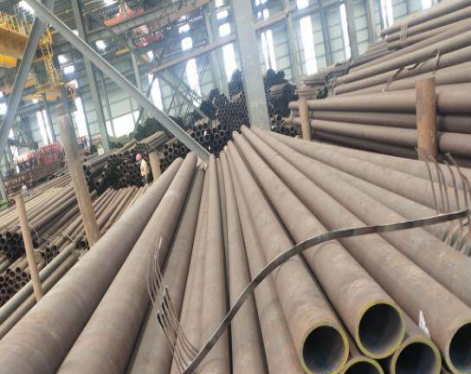The raw materials commonly used in pipelines are: plates, pipes and forgings. The following is the introduction of these three pipe weight calculation methods:
1. Plates: Common plates are coiled plates, flat plates, and flat plates. The coiled plates are usually delivered in rolls. The advantage is that the length can be arbitrarily taken as needed. The disadvantage is that there must be corresponding uncoiling equipment and the flatness of the plate is average. Flat plates are usually delivered in sheets. The advantage is that the flat surface is flat, which is convenient for transportation and use. The disadvantage is that sometimes the utilization rate of the plate is low. The uncoiling board is formed by cutting the coiled board into pieces by the shearing machine and smoothing the board surface. In addition to observing the flatness and smoothness of the surface and edges, there is a simple method to distinguish between the flat plate and the flat plate: the real flat plate is marked with the steel factory when it leaves the factory, such as the manufacturer, specifications, steel number, etc. There are no such marks on the open tablet.
The calculation formula of the theoretical weight of the plate is:Theoretical weight of carbon steel plate=Length*width*wall thickness*7.85/106(The unit is mmand kg)
Theoretical weight of stainless steel=Length*width*wall thickness*7.91/106(The unit is mm and kg)
For example: a 1500*6000*6 stainless steel plate
Theoretical weight =1500*6000*6*7.91=71190000=71.19kg
2. Pipe: This mainly refers to round pipe, which can be divided into welded pipe (straight seam welded pipe, spiral welded pipe) and seamless pipe. Welded pipe (also called seamed pipe) is usually used for pipes with low pressure (20kg/cm²), of which spiral The pipe is mainly used for
large-diameter (such as DN400 and above) systems, so its wall thickness is generally thin (usually below SCH10). Seamless pipes are generally used for pipes with higher pressure. Due to the limitation of the production process of seamless pipes, our commonly used industrial seamless pipes are usually hot rolled, so the wall thickness of hot rolled seamless pipes on the market is available. For pipes of a certain caliber, there is usually a certain lower limit (generally above SCH10), such as:
Theoretical weight of carbon steel plate=( Outer diameter-wall thickness)*wall thickness*0.02466, the unit is mm and kg
Theoretical weight of stainless steel=( Outer diameter-wall thickness)*wall thickness*0.02466,the unit is mm and kg
For example: A 6 meter long 273*8 stainless steel tube
Theoretical weight per meter=(273-8)*8*0.02491=52.81kg
The theoretical weight of 6 meters=52.81*6=316.86kg
3. Forgings: Forgings are usually used to make flanges, bearing parts and certain joints.
1. Plates: Common plates are coiled plates, flat plates, and flat plates. The coiled plates are usually delivered in rolls. The advantage is that the length can be arbitrarily taken as needed. The disadvantage is that there must be corresponding uncoiling equipment and the flatness of the plate is average. Flat plates are usually delivered in sheets. The advantage is that the flat surface is flat, which is convenient for transportation and use. The disadvantage is that sometimes the utilization rate of the plate is low. The uncoiling board is formed by cutting the coiled board into pieces by the shearing machine and smoothing the board surface. In addition to observing the flatness and smoothness of the surface and edges, there is a simple method to distinguish between the flat plate and the flat plate: the real flat plate is marked with the steel factory when it leaves the factory, such as the manufacturer, specifications, steel number, etc. There are no such marks on the open tablet.
The calculation formula of the theoretical weight of the plate is:Theoretical weight of carbon steel plate=Length*width*wall thickness*7.85/106(The unit is mmand kg)
Theoretical weight of stainless steel=Length*width*wall thickness*7.91/106(The unit is mm and kg)
Theoretical weight =1500*6000*6*7.91=71190000=71.19kg
2. Pipe: This mainly refers to round pipe, which can be divided into welded pipe (straight seam welded pipe, spiral welded pipe) and seamless pipe. Welded pipe (also called seamed pipe) is usually used for pipes with low pressure (20kg/cm²), of which spiral The pipe is mainly used for
large-diameter (such as DN400 and above) systems, so its wall thickness is generally thin (usually below SCH10). Seamless pipes are generally used for pipes with higher pressure. Due to the limitation of the production process of seamless pipes, our commonly used industrial seamless pipes are usually hot rolled, so the wall thickness of hot rolled seamless pipes on the market is available. For pipes of a certain caliber, there is usually a certain lower limit (generally above SCH10), such as:
Φ27-Φ48 wall thickness≥2.0
Φ57-Φ76 wall thickness≥3.0
Φ89-Φ159 wall thickness≥3.5
Φ168-Φ219 wall thickness≥4.0
Φ273 wall thickness≥6.0
Φ325-Φ377 wall thickness≥8.0
Φ402-Φ426 wall thickness≥9.0
Φ530-Φ630 wall thickness≥10.0
The calculation formula of the theoretical weight of the pipe per meter is:Φ57-Φ76 wall thickness≥3.0
Φ89-Φ159 wall thickness≥3.5
Φ168-Φ219 wall thickness≥4.0
Φ273 wall thickness≥6.0
Φ325-Φ377 wall thickness≥8.0
Φ402-Φ426 wall thickness≥9.0
Φ530-Φ630 wall thickness≥10.0
Theoretical weight of carbon steel plate=( Outer diameter-wall thickness)*wall thickness*0.02466, the unit is mm and kg
Theoretical weight of stainless steel=( Outer diameter-wall thickness)*wall thickness*0.02466,the unit is mm and kg
For example: A 6 meter long 273*8 stainless steel tube
Theoretical weight per meter=(273-8)*8*0.02491=52.81kg
The theoretical weight of 6 meters=52.81*6=316.86kg
3. Forgings: Forgings are usually used to make flanges, bearing parts and certain joints.









